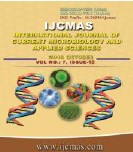


 National Academy of Agricultural Sciences (NAAS)
National Academy of Agricultural Sciences (NAAS)

|
PRINT ISSN : 2319-7692
Online ISSN : 2319-7706 Issues : 12 per year Publisher : Excellent Publishers Email : editorijcmas@gmail.com / submit@ijcmas.com Editor-in-chief: Dr.M.Prakash Index Copernicus ICV 2018: 95.39 NAAS RATING 2020: 5.38 |
A field experiment was conducted during the rabi season of 2017-18 on fodder maize crop (var. SHIATS Makka- 2) at the Crop Research Farm, Department of Agronomy, Naini Agricultural Institute, SHUATS, Allahabad (U.P.). The soil of the experimental field was sandy loam with low organic carbon (0.45%) and a soil pH of 7.6. The experiment comprised of three planting geometry viz., 40 ×10 cm, 50× 10 cm, 60×10 cm and 2 nitrogen levels 90 kg N ha-1 and 120 kg N ha-1 respectively, with 18 treatments replicated thrice and laid out in Randomized Block Design. The experiment was conducted to evaluate the growth and yield of fodder maize (Zea mays L.). The result revealed that treatment T17 [120 kg N ha-1 + (50% N through vermicompost + 50%N through urea) + Seed inoculated with Azotobacter + 50x10cm] recorded higher crude protein (9.567), Ash (5.270%), Gross return ( 89120 ha-1), Net Return ( 51351.6 ha-1), B: C (2.36) ratio.
 |
 |
 |
 |
 |